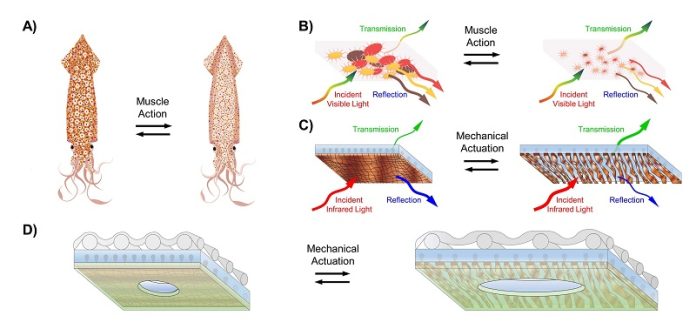
Imagine a fabric that can adjust to your body’s temperature—keeping you warm when it’s cold and cooling you down when you’re hot.
Inspired by the way squid change color, researchers at the University of California, Irvine have developed a special material that can adjust to your temperature needs.
This fabric, which is breathable, washable, and flexible, could revolutionize cold-weather clothing.
The team published their findings in APL Bioengineering.
Squid skin is made up of multiple layers, which allow the animal to change its color by controlling how it reflects light.
One of these layers contains tiny organs called chromatophores, which expand and contract to change how much light is transmitted.
The researchers were inspired by this mechanism but focused on the infrared spectrum rather than visible light.
When humans heat up, we emit some of that heat as invisible infrared radiation.
The fabric the team created can adapt to this heat emission, allowing the wearer to regulate their body temperature.
The material is made of a special polymer covered with copper “islands.”
As the fabric stretches, the copper islands move apart, changing how the fabric reflects and transmits infrared light. This makes it possible to control the temperature of the clothing.
In earlier work, the team demonstrated how this material could adapt to infrared heat.
Now, they’ve improved it to make the fabric more practical by ensuring it’s breathable, washable, and easy to integrate into regular clothing. To make it washable, the team added a thin protective layer.
They also perforated the material with tiny holes, allowing air and water vapor to pass through, making it as breathable as cotton. The fabric was then attached to a mesh, making it easy to incorporate into garments.
The team tested the fabric’s heat-regulating abilities using infrared spectroscopy and a device called a sweating guarded hot plate, which simulates how fabric interacts with heat and moisture.
Despite the added layers and perforations, the material continued to perform well in managing temperature.
This breakthrough opens the door to new possibilities for wearable technology, especially in cold-weather gear like ski jackets, gloves, and thermal socks.
Additionally, the same techniques used to make this fabric could be applied to other products like stretchable electronics and energy-harvesting materials.
“Our material could be used in many types of wearable systems, and we’re excited about the future possibilities,” said lead researcher Alon Gorodetsky.



